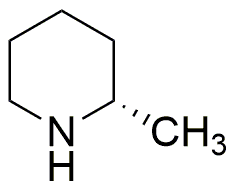(S)-(+)-2-Methylpiperidine is widely utilized in research focused on:
- Synthesis of Pharmaceuticals: This compound serves as a key intermediate in the synthesis of various pharmaceutical agents, particularly in the development of drugs targeting neurological disorders.
- Ligand Development: It is used in the creation of ligands for metal catalysts, enhancing the efficiency of chemical reactions in organic synthesis.
- Flavor and Fragrance Industry: The compound is employed in the formulation of flavoring agents and fragrances, providing unique aromatic properties that enhance product appeal.
- Research in Organic Chemistry: It plays a significant role in organic chemistry research, particularly in studying reaction mechanisms and developing new synthetic pathways.
- Material Science: The compound is explored for its potential applications in the development of novel materials, including polymers and coatings, due to its unique structural properties.
General Information
Properties
Safety and Regulations
Applications
(S)-(+)-2-Methylpiperidine is widely utilized in research focused on:
- Synthesis of Pharmaceuticals: This compound serves as a key intermediate in the synthesis of various pharmaceutical agents, particularly in the development of drugs targeting neurological disorders.
- Ligand Development: It is used in the creation of ligands for metal catalysts, enhancing the efficiency of chemical reactions in organic synthesis.
- Flavor and Fragrance Industry: The compound is employed in the formulation of flavoring agents and fragrances, providing unique aromatic properties that enhance product appeal.
- Research in Organic Chemistry: It plays a significant role in organic chemistry research, particularly in studying reaction mechanisms and developing new synthetic pathways.
- Material Science: The compound is explored for its potential applications in the development of novel materials, including polymers and coatings, due to its unique structural properties.
Documents
Safety Data Sheets (SDS)
The SDS provides comprehensive safety information on handling, storage, and disposal of the product.
Product Specification (PS)
The PS provides a comprehensive breakdown of the product’s properties, including chemical composition, physical state, purity, and storage requirements. It also details acceptable quality ranges and the product's intended applications.
Certificates of Analysis (COA)
Search for Certificates of Analysis (COA) by entering the products Lot Number. Lot and Batch Numbers can be found on a product’s label following the words ‘Lot’ or ‘Batch’.
*Catalog Number
*Lot Number
Certificates Of Origin (COO)
This COO confirms the country where the product was manufactured, and also details the materials and components used in it and whether it is derived from natural, synthetic, or other specific sources. This certificate may be required for customs, trade, and regulatory compliance.
*Catalog Number
*Lot Number
Safety Data Sheets (SDS)
The SDS provides comprehensive safety information on handling, storage, and disposal of the product.
DownloadProduct Specification (PS)
The PS provides a comprehensive breakdown of the product’s properties, including chemical composition, physical state, purity, and storage requirements. It also details acceptable quality ranges and the product's intended applications.
DownloadCertificates of Analysis (COA)
Search for Certificates of Analysis (COA) by entering the products Lot Number. Lot and Batch Numbers can be found on a product’s label following the words ‘Lot’ or ‘Batch’.
*Catalog Number
*Lot Number
Certificates Of Origin (COO)
This COO confirms the country where the product was manufactured, and also details the materials and components used in it and whether it is derived from natural, synthetic, or other specific sources. This certificate may be required for customs, trade, and regulatory compliance.


